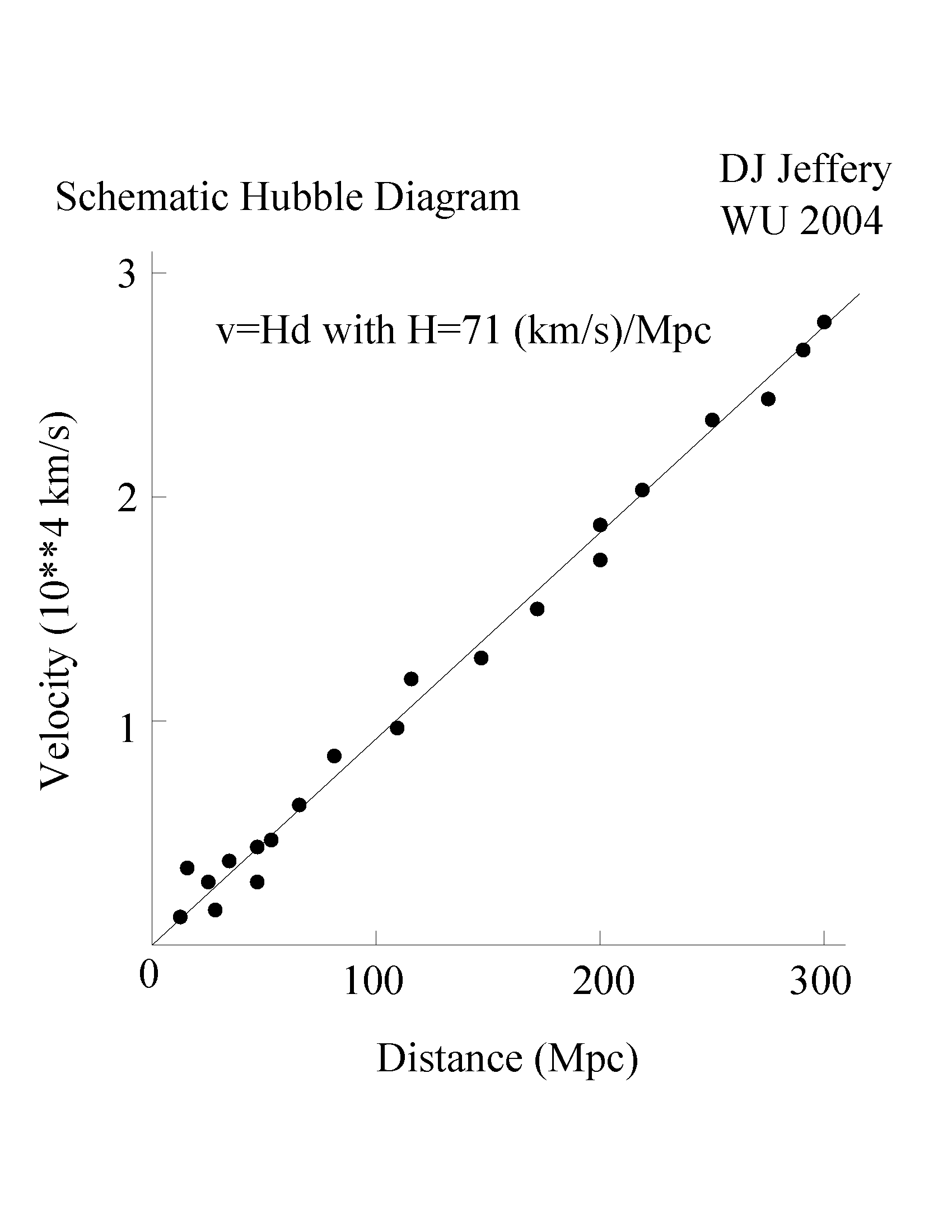where v_redshift = zc is
redshift velocity,
r_observable is a direct observable kind of distance
(usually a luminosity distance),
and H_0 is
Hubble constant.
The subscripts can be dropped if you know what you mean.
By convention
redshift velocity
is measured in kilometers per second (km/s)
and distance in
megaparsec (Mpc).
The
Hubble constant
which is the slope of the best-fit line on the plot
has units of (km/s)/Mpc.
You, me, the Milky Way,
the Local Group,
and all other gravitationally bound systems throughout the
observable universe
do NOT expand.
Only the space
between gravitationally bound systems expands.
But actually, the
expanding universe theory
predicts a general scaling up of the
observable universe.
So every observer seems to see himself/herself at the center of
expansion at first glance.
All distances between points participating in the
mean expansion of the universe
scale up with
cosmic time
(with zero time at the Big Bang) by the
cosmic scale factor a(t).
The cosmic scale factor
for our current epoch (conventionally cosmic time t_0)
is conventionally set to 1 and given symbol a_0. Thus a(t=t_0) = a_0 = 1.
Albert Einstein (1879--1955)
failed to discover the
expanding universe theory.
It was discovered independently
by Alexander Alexandrovich Friedmann (1888--1925)
and Georges Lemaitre (1894--1966)
in the 1920s.
Let r be a proper distance
(i.e., a distance that can be measured at one instant in time with a ruler)
between two points participating in the
mean expansion of the universe.
Now
where r_0 is the
comoving distance
(a time independent distance equal to the
proper distance at the present
cosmic time t_0),
and a(t) is the cosmic scale factor.
So all r's scale up and down with cosmic time
as determined by a(t).
Taking the derivative
of r with respect to time t (a calculus operation)
gives
where v = dr/dt is the rate of change of r and da/dt is the rate of change of a(t).
Note, v = dr/dt is the
recession velocity.
It's NOT an ordinary velocity:
it's a rate of growth of space.
Now r_0 = v/(da/dt) and substituting this into the second to last equation and rearranging gives
The quantity [(da/dt)/a(t)] depends on cosmic time,
but NOT on position.
We evaluate it for the present cosmic time
and call it the
Hubble constant
where subscript 0 means evaluated at the present
cosmic time.
Now we have the general
Hubble's law
But there is a big problem.
The recession velocity v
and the proper distance
are NOT in general direct observables.
However, it can be shown that to
1st order in small z, we
obtain the ordinary Hubble's law given above.
There are many contemporary determinations of the
Hubble constant.
The values are converging to H_0 = 70 (km/s)/Mpc to within a few percent.
Nowadays H_0 = 70 (km/s)/Mpc is taken as the
fiducial value for many calculations.
Formulae containing the
Hubble constant
can be written as 70 (km/s)/Mpc * h_70, where h_70 = H_0/[70 (km/s)/Mpc] is left as a variable.
The evidence when first presented did convince people that the
expanding universe
was probably true.
Other evidence since that time has confirmed
the expanding universe theory.
Features:
vredshift = H0 robservable ,
r = r0*a(t)
v = dr/dt = r0*(da/dt) ,
v = [(da/dt)/a(t)]*r ,
H0 = [(da/dt)/a(t)]0 ,
v = H0r .
